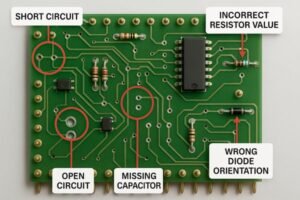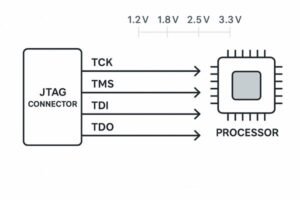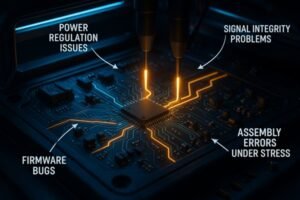Struggling with circuit failures? Environmental hazards can wreck your electronics. Choosing the right conformal coating is key to long-term reliability and performance for your printed circuit board assemblies (PCBAs).
Key factors include the operating environment (temperature, humidity, chemical exposure), electrical requirements (dielectric strength, frequency effects), the specific application method available, repair and rework needs, and adherence to regulatory compliance standards (like IPC-CC-830 or UL746E).

Selecting the right conformal coating might seem like a small detail, but it’s a decision that has significant implications for your product's lifespan and functionality. It's not just about slapping on a protective layer; it's about understanding the nuanced interactions between the coating, the components, and the operational environment. Let's explore how to navigate these choices effectively to ensure your electronics are truly protected and perform optimally, especially as designs get more complex.
How To Choose The Right Conformal Coating?
Confused by the array of coating options? Choosing incorrectly leads to premature failures and costly redesigns. Understanding key criteria ensures your electronics get the best possible protection for their intended application.
Consider the primary function (e.g., moisture, chemical, dust protection), the full operating temperature range, dielectric requirements like dielectric constant and loss tangent, mechanical flexibility, ease of application and repair, and overall cost. You'll typically evaluate materials like acrylic (AR), silicone (SR), urethane (UR), epoxy (ER), and parylene (XY).
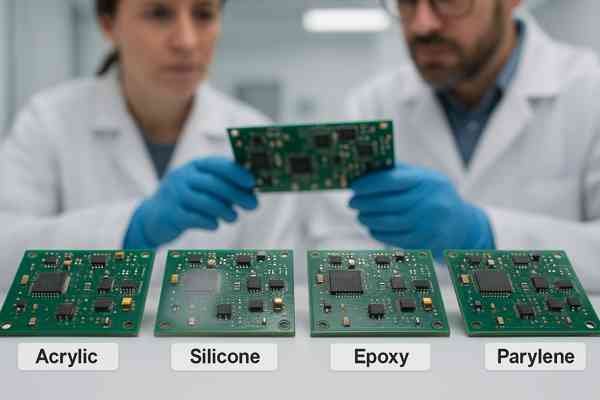
When I'm tasked with selecting a conformal coating, the process involves several critical thinking steps to ensure all angles are covered. It's more than just picking a material from a list; it's about a holistic approach to protection and performance.
Identifying the Primary Stressor
My first step is always to identify the primary stressor the PCBA will face. Is it extreme humidity, as found in tropical marine environments? Will it be exposed to corrosive chemicals in an industrial plant? Or perhaps the main concern is high operating temperatures in an automotive engine compartment, or simply the ingress of fine dust in a consumer electronic device. Understanding this dominant threat is crucial because it immediately helps to narrow down the suitable types of coatings. For example, if chemical resistance1 is paramount, urethanes and epoxies often come to the forefront. If extreme temperature cycling is expected, silicones with their inherent flexibility become strong candidates.
The Overlooked Electrical Impact: Dynamic Dielectric Properties
A frequently underestimated factor in conformal coating selection is its dynamic dielectric impact, especially in high-frequency (RF) and high-density digital circuits. While coatings primarily offer physical protection, their electrical properties can significantly alter circuit performance, particularly as signal speeds and component densities increase. We must move beyond thinking of the coating as just a static "protective layer" and consider it an "electrically active component." The coating's dielectric constant (\(\epsilon_{r}\)) and dissipation factor (\(\text{tan }\delta\)) can change the impedance of transmission lines and introduce signal loss, especially at gigahertz frequencies. For instance, a coating with a higher \(\epsilon_{r}\) (e.g., some epoxies might have an \(\epsilon_{r}\) of 4-5, while some silicones or acrylics might be closer to 2.5-3.5) can increase parasitic capacitance between traces or between traces and ground planes. This can detune sensitive RF matching networks or slow down high-speed digital signal edges, potentially leading to signal integrity issues. I always scrutinize these properties from manufacturer datasheets for any board operating above a few hundred megahertz or with critical analog circuitry. The thickness of the coating also plays a role here; a thicker coating, even with a moderate \(\epsilon_{r}\), can have a more pronounced effect.
Comparing Common Coating Types
Once the primary needs are understood, I then compare the general characteristics of the main coating families. Each has its trade-offs:
| Feature | Acrylic (AR) | Silicone (SR) | Urethane (UR) | Epoxy (ER) | Parylene (XY) |
|---|---|---|---|---|---|
| Primary Use | General, moisture | High temp, moisture | Chemical, moisture | Harsh env., abrasion | Uniform, thin, high protection |
| Dielectric Strength (\(\text{V/mil}\), ASTM D149) | ~350 - 1500 | ~350 - 1000 | ~1500 - 3500 | ~1000 - 2500 | ~5000 - 7000 (Type C/N) |
| Max Operating Temp. (°C) | ~85 - 125 | ~200+ | ~125 - 130 | ~150 - 200 (specialized) | ~80-125 (N/C), up to 350 (HT) |
| Moisture Resistance | Fair to Good | Very Good to Excellent | Good to Very Good | Good to Very Good | Excellent |
| Chemical Resistance | Poor to Fair | Fair to Good | Good to Excellent | Excellent | Excellent |
| Abrasion Resistance | Poor | Fair | Good | Excellent | Poor (thin layer) |
| Flexibility | Good | Excellent | Good | Poor (rigid) | Moderate |
| Repairability | Easiest | Moderate | Difficult | Very Difficult | Very Difficult |
| Common Application | Spray, Brush, Dip | Spray, Brush, Dip | Spray, Brush, Dip | Spray, Brush, Dip | Vapor Deposition |
| Adhesion | Good (many substrates) | Good (with primer often) | Good | Excellent | Excellent (mechanical bond) |
| IPC-CC-830C Qualified? | Yes (many) | Yes (many) | Yes (many) | Yes (some) | Yes (many) |
(Note: These are typical values. Always consult specific manufacturer datasheets.)
For a detailed introduction to these common coatings, please refer to my article: What Are the Properties of Acrylic Conformal Coatings
Key Standards and Application Considerations
Finally, I consider industry standards and practical application aspects. The IPC-CC-830C2 (Qualification and Performance of Electrical Insulating Compound for Printed Board Assemblies) is a crucial benchmark, as it establishes requirements for conformal coatings, including aspects like appearance, thickness, flexibility, and resistance to various environmental stresses. Adherence to UL746E3 is also important for flammability ratings, especially for consumer products. The application method is also a key practical factor. Do you have automated spray or dip coating equipment for high-volume production, or will it be a manual brush application for small batches or prototypes? Parylene, for instance, offers superb protection but requires specialized Chemical Vapor Deposition (CVD)4 equipment, which is a significant investment and might only be feasible for high-value or high-reliability applications. Cost, of course, is always a factor, but it must be weighed against the potential cost of field failures and warranty claims.
Which Conformal Coating Is Best For High Humidity Environments?
Worried about moisture damage to your electronics? High humidity relentlessly cripples unprotected circuits over time. Selecting a coating with excellent moisture barrier properties is absolutely essential for survival in these conditions.
For high humidity, Parylene (XY) and Silicone (SR) coatings generally offer the best and most reliable moisture resistance. Urethanes (UR) also perform well. Acrylics (AR) provide fair protection but might not be suitable for prolonged high-humidity or condensing environments.
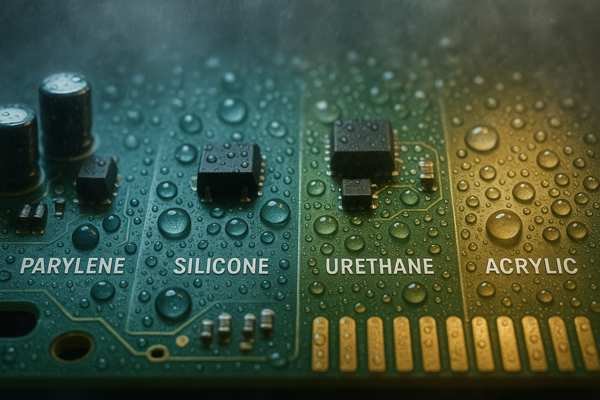
When I'm designing for environments where humidity is a constant enemy—think of electronics deployed in tropical regions, marine applications, or unconditioned industrial sheds—the coating's ability to act as a moisture barrier becomes the top priority.
Understanding Moisture Resistance: Key Metrics
The primary metric I look at here is the Water Vapor Transmission Rate5 (\(\text{WVTR}\)), often measured in grams per square meter per day (\(\text{g/m}^2\text{/day}\)) for a given thickness. A lower \(\text{WVTR}\) indicates a better barrier against moisture. Another important property is water absorption, typically expressed as a percentage of weight gain after 24 hours of immersion at 23°C (e.g., per ASTM D570). Low water absorption is desirable as absorbed moisture can degrade the coating's dielectric properties and reduce its adhesion over time.
Comparing Coatings for High Humidity Performance
Here's a comparative look at how different coating types generally perform in high humidity:
| Coating Type | Typical \(\text{WVTR}\) (\(\text{g/m}^2\text{/day for } 25\mu\text{m}\)) | Typical Water Absorption (\(\%\), ASTM D570) | Key Advantages for Humidity | Key Limitations for Humidity |
|---|---|---|---|---|
| Parylene (C/N) | 0.06 - 0.1 | \(< 0.1\%\) | Exceptional barrier, very thin, pinhole-free, excellent crevice penetration | Specialized application process (CVD), higher cost |
| Silicone (SR) | 1 - 10 | \(0.1 - 0.5\%\) | Highly hydrophobic, flexible over wide temp range, good adhesion | Higher \(\text{WVTR}\) than Parylene, some can be soft |
| Urethane (UR) | 5 - 15 | \(0.5 - 2.0\%\) | Good balance of moisture/chemical resistance, durable | Can be harder to repair, \(\text{WVTR}\) higher than SR/XY |
| Acrylic (AR) | \(> 20\) | \(0.1 - 0.4\%\) | Easy to apply/repair, low cost | Most permeable to moisture, not for prolonged high humidity |
| Epoxy (ER) | 0.5 - 5 | \(0.1 - 0.5\%\) | Good moisture/chemical barrier, very hard/abrasion resistant | Rigid (can stress components), very difficult to repair |
(Note: \(\text{WVTR}\) and Water Absorption values are typical and can vary significantly between specific formulations. Always consult manufacturer datasheets.)
Parylene types, especially Parylene C, offer the lowest \(\text{WVTR}\), making them a top choice for critical applications. Silicones follow, providing excellent hydrophobicity and flexibility. Epoxies can also offer very good moisture barrier properties, but their rigidity is a concern. Urethanes provide a good middle ground, while acrylics are generally reserved for less demanding humidity conditions or where ease of repair is paramount. For Parylene C, the \(\text{WVTR}\) can be exceptionally low, often cited in the range of 0.06 to 0.1 \(\text{g/m}^2\text{/day}\) for a 25\(\mu\text{m}\) (1 mil) film. Silicones typically have a \(\text{WVTR}\) in the range of 1 to 10 \(\text{g/m}^2\text{/day}\) for a 25-50\(\mu\text{m}\) film. Urethanes can range from 5 to 15 \(\text{g/m}^2\text{/day}\). Acrylics might have a \(\text{WVTR}\) \(> 20 \text{ g/m}^2\text{/day}\).
Validation and Real-World Implications
For validation, I often refer to testing procedures outlined in standards like IPC-CC-830C, which includes humidity exposure tests (e.g., 10 days at 85°C/\(85\% \text{ RH}\) followed by insulation resistance testing). In one of my past projects designing an environmental sensor for deployment in the Amazon rainforest, we initially prototyped with an acrylic coating due to ease of rework. However, during accelerated life testing that simulated the high humidity (\(>85\% \text{ RH}\) for extended periods) and temperature fluctuations, we observed significant corrosion on fine-pitch IC leads after just a few weeks. Switching to a silicone coating, which had a significantly lower \(\text{WVTR}\) and better adhesion under humid conditions, resolved the issue entirely, even though it added a bit to the unit cost and made rework slightly more complex. This underscored the critical importance of not underestimating sustained high humidity.
What Is The Best Conformal Coating For High-Temperature Applications?
Facing extreme heat in your product's operating environment? High temperatures relentlessly degrade electronic components and materials fast. You absolutely need a coating that maintains its protective integrity and electrical insulation under severe thermal stress.
Silicone (SR) coatings are generally the best choice for most high-temperature applications, often rated for continuous use up to 200°C or even slightly higher. Some specialized Parylene types (like Parylene HT®) and certain Epoxies (ER) can also handle very high temperatures.

When a design specifies operation in high-temperature environments—such as automotive under-hood electronics, industrial process controls near furnaces, or downhole drilling equipment—the thermal stability of the conformal coating becomes a primary design constraint.
Defining "High Temperature" for Electronics
What constitutes "high temperature" can vary. For many commercial electronics, anything above 85°C is considered elevated. For industrial or automotive, continuous operation might be expected at 125°C, 150°C, or even higher. The key is to look for the coating's maximum continuous operating temperature and its glass transition temperature (\(T_{g}\)). Above \(T_{g}\), the material properties can change significantly, often becoming softer or losing some protective qualities.
Comparing Coatings for High-Temperature Performance
Let's look at how different coatings stack up for thermal demands:
| Coating Type | Max Continuous Operating Temp (°C) | Short-Term Max Temp (°C) (Typical) | Thermal Cycling Performance | Flexibility at High Temp | Key Considerations for High Temp |
|---|---|---|---|---|---|
| Silicone (SR) | ~200+ | Up to 250 | Excellent | Excellent | Maintains properties well, low modulus good for \(\text{CTE}\) mismatch. |
| Parylene HT® | ~350 | Up to 450 | Very Good | Moderate | Exceptional stability, but specialized type and CVD application. |
| Epoxy (ER) | ~150 (some up to 200) | ~170-220 | Fair to Good | Poor (becomes brittle) | Can become very rigid, \(\text{CTE}\) mismatch can stress components. |
| Urethane (UR) | ~125 - 130 | ~150-155 | Fair | Moderate to Poor | Can soften or degrade above limits, some yellowing. |
| Acrylic (AR) | ~85 (some up to 125) | ~100-135 | Fair to Poor | Poor (can soften) | Generally not for high-temp; can degrade, soften, or outgas. |
| Parylene (N/C) | ~80 (N), ~125 (C) | ~100 (N), ~140 (C) | Good | Moderate | Standard grades have lower temp limits than Parylene HT®. |
(Note: Temperature limits are general; always consult specific product datasheets from manufacturers like Dow, Momentive, Henkel, Elantas, Chase, Specialty Coating Systems, etc.)
Silicones are clear leaders for broad high-temperature applications due to their stability and flexibility. Parylene HT® is for extreme niche applications. Epoxies can work but require careful mechanical consideration. Urethanes and Acrylics are generally limited to more moderate temperature ranges.
Critical Factor: Thermal Cycling and \(\text{CTE}\) Mismatch
It's not just the maximum continuous temperature that matters, but also the ability to withstand thermal cycling – repeated heating and cooling. As I mentioned with epoxies, a large mismatch in Coefficient of Thermal Expansion6 (\(\text{CTE}\)) between the coating, the PCB, and the components can be detrimental. Silicones, due to their low modulus of elasticity (high flexibility), are excellent at absorbing these stresses. I remember a project involving an industrial sensor for a steel mill. The initial coating, a rigid high-temperature epoxy, started showing micro-cracks after about 500 thermal cycles from ambient to 150°C. Switching to a high-temperature, flexible silicone (rated for 200°C) allowed the device to pass well over 2000 cycles without any degradation in the coating or underlying circuitry. This experience highlighted the importance of dynamic thermal performance, not just static temperature tolerance.
Which Conformal Coatings Are Easy To Repair?
Need to rework or repair components on your coated circuit boards? Some coatings can turn a simple repair into a nightmare. Choosing a coating that allows for practical repairability can save significant time, cost, and frustration, especially during development or for serviceable products.
Acrylic (AR) coatings are by far the easiest to repair, typically removable with common solvents like isopropyl alcohol or specialized removers. Some Silicone (SR) and Urethane (UR) coatings can be repaired by spot removal or careful soldering through, but it's more challenging. Epoxy (ER) and Parylene (XY) are generally very difficult to repair.
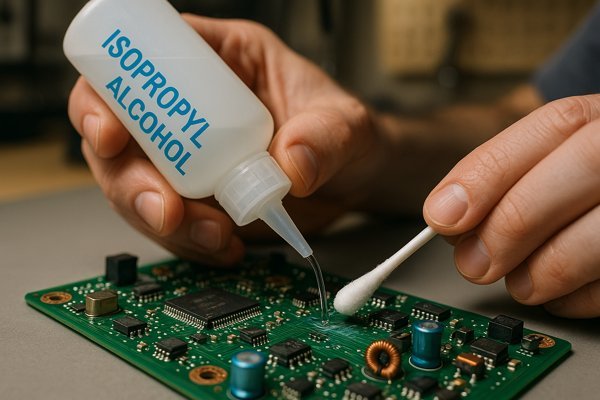
The need for repair or rework is an inevitable part of the electronics lifecycle, from debugging prototypes to servicing field returns. The choice of conformal coating can dramatically impact the feasibility and cost of these operations.
What Does "Repairability" Really Mean?
When I assess "repairability," I consider several factors:
- Ease of Localized Removal: Can the coating be removed from a small area without affecting the rest of the board?
- Type of Removal Process: Is it a simple solvent wipe, or does it require aggressive chemicals, heat, or mechanical abrasion?
- Ability to Solder Through: Can components be desoldered and resoldered directly through the coating?
- Residue and Cleaning: Does the removal or solder-through process leave harmful or difficult-to-clean residues?
- Ease of Re-application: How easily can the repaired area be re-coated to restore protection, and will the new coating adhere well?
Ease of Repair: A Material-by-Material Breakdown
Acrylic (AR): The Champion of Rework
Acrylic coatings are the clear winners when it comes to ease of repair. Most acrylics can be readily dissolved and removed using common, relatively mild solvents like isopropyl alcohol (IPA)7, n-butyl acetate, or proprietary solvent blends specifically designed for acrylic removal. For localized repairs, I've often used solvent pens or a small brush dipped in solvent. Many acrylics can also be soldered through directly; the heat from the soldering iron melts and vaporizes the coating in the immediate vicinity. It's good practice to clean any resulting flux and coating residue from the repaired area before reapplying a fresh touch-up of acrylic coating. Their excellent repairability makes them ideal for prototypes, products undergoing frequent revisions, or devices where field serviceability is a primary requirement.
Silicone (SR): Moderate but Manageable
Silicone coatings are moderately repairable. Some softer silicone formulations can be mechanically removed by careful cutting and peeling, or by gentle abrasion using a soft abrasive tool. Chemical removal is possible but often requires more aggressive solvents (e.g., specialized silicone removers containing hydrocarbons or siloxanes) which might not be compatible with all PCB components or plastics. Soldering through silicone is sometimes possible, particularly with softer formulations, but it can be a bit messy and leave behind difficult-to-remove residues. Thorough cleaning is essential before re-coating to ensure good adhesion.
Urethane (UR): More Challenging Repairs
Urethane coatings are generally more difficult to remove than acrylics. They require stronger, specialized chemical strippers (which can be hazardous and require careful handling). The removal process can be slow, often requiring soaking. Thermal removal (using a hot air gun at a controlled temperature, typically around 150-200°C depending on the urethane) or mechanical abrasion are other options for localized removal, but care must be taken not to damage the board or components. Soldering through some urethane formulations is possible, but a significant health hazard exists: this process can release isocyanate vapors8 (like TDI or MDI), which are potent respiratory sensitizers. If soldering through urethane, it must be done in a well-ventilated area with appropriate local exhaust ventilation and personal protective equipment (PPE), including a respirator with organic vapor cartridges.
Epoxy (ER) and Parylene (XY): The Most Difficult to Repair
Epoxy (ER) coatings are notoriously difficult to repair due to their high crosslink density and excellent chemical resistance. Solvents are largely ineffective. Removal almost always involves aggressive mechanical abrasion (e.g., grinding, scraping, or even localized media blasting), which carries a very high risk of damaging PCB tracks, pads, or nearby components. For most practical purposes, I consider boards fully coated with epoxy to be non-repairable or only repairable with extreme effort and risk.
Parylene (XY), being chemically inert and forming a highly conformal film, is also very challenging to remove. Chemical stripping is not feasible. The most common method for localized removal is micro-abrasion (similar to sandblasting but with very fine abrasive powder and precise control), which requires specialized equipment and considerable skill. It's not a technique suited for extensive rework or field repairs.
Quick Reference: Repairability Comparison
| Coating Type | Ease of Removal | Common Removal Method(s) | Solder Through? | Health & Safety Notes for Soldering Through |
|---|---|---|---|---|
| Acrylic (AR) | Easiest | Solvents (IPA, n-butyl acetate, specialized) | Yes, generally | Good ventilation for solvent/flux fumes |
| Silicone (SR) | Moderate | Mechanical (peel, abrade), some solvents, thermal | Some formulations | Good ventilation for fumes |
| Urethane (UR) | Difficult | Specialized solvents, thermal, abrasion | Some formulations | HIGH RISK: Isocyanate vapors. Specialized ventilation & PPE REQUIRED. |
| Epoxy (ER) | Very Difficult | Abrasion, very aggressive chemicals (limited) | No | N/A |
| Parylene (XY) | Very Difficult | Micro-abrasion | No | N/A |
Strategic Coating Choices for Prototyping vs. Production
From my own experience in developing medical diagnostic equipment, we often used acrylic coatings extensively during the early DVT (Design Verification Test) phases. This allowed our team to quickly iterate on designs, swap out components, and troubleshoot circuits without major delays caused by coating removal. Once the design was stable and heading for PVT (Production Validation Test) and eventual mass production, we would then critically assess if the long-term reliability and environmental exposure demands necessitated a move to a more robust but harder-to-repair coating, like a specific urethane or silicone. This involved a careful trade-off analysis between manufacturability, serviceability, and the required level of protection.
Conclusion
Selecting the right conformal coating involves careful consideration of environmental, electrical, application, and repairability factors. Prioritizing these based on your specific application needs will ensure optimal protection and long-term performance for your electronics.
-
Chemical resistance is vital for ensuring the longevity and reliability of electronic components in harsh environments. Discover more about its importance here. ↩
-
Understanding IPC-CC-830C is essential for ensuring quality in conformal coatings, which can significantly impact product reliability. ↩
-
Exploring UL746E will help you grasp the flammability standards necessary for consumer product safety and compliance. ↩
-
Learning about CVD can provide insights into advanced coating techniques that enhance product durability and performance. ↩
-
Understanding WVTR is crucial for selecting coatings that effectively resist moisture, ensuring durability and performance in humid environments. ↩
-
Learning about CTE is essential for ensuring compatibility between materials in electronic devices, preventing failures. ↩
-
Explore the versatility of isopropyl alcohol (IPA) in electronics repair, including its effectiveness in cleaning and removing coatings. ↩
-
Learn about the dangers of isocyanate vapors during soldering, including safety measures to protect yourself. ↩



